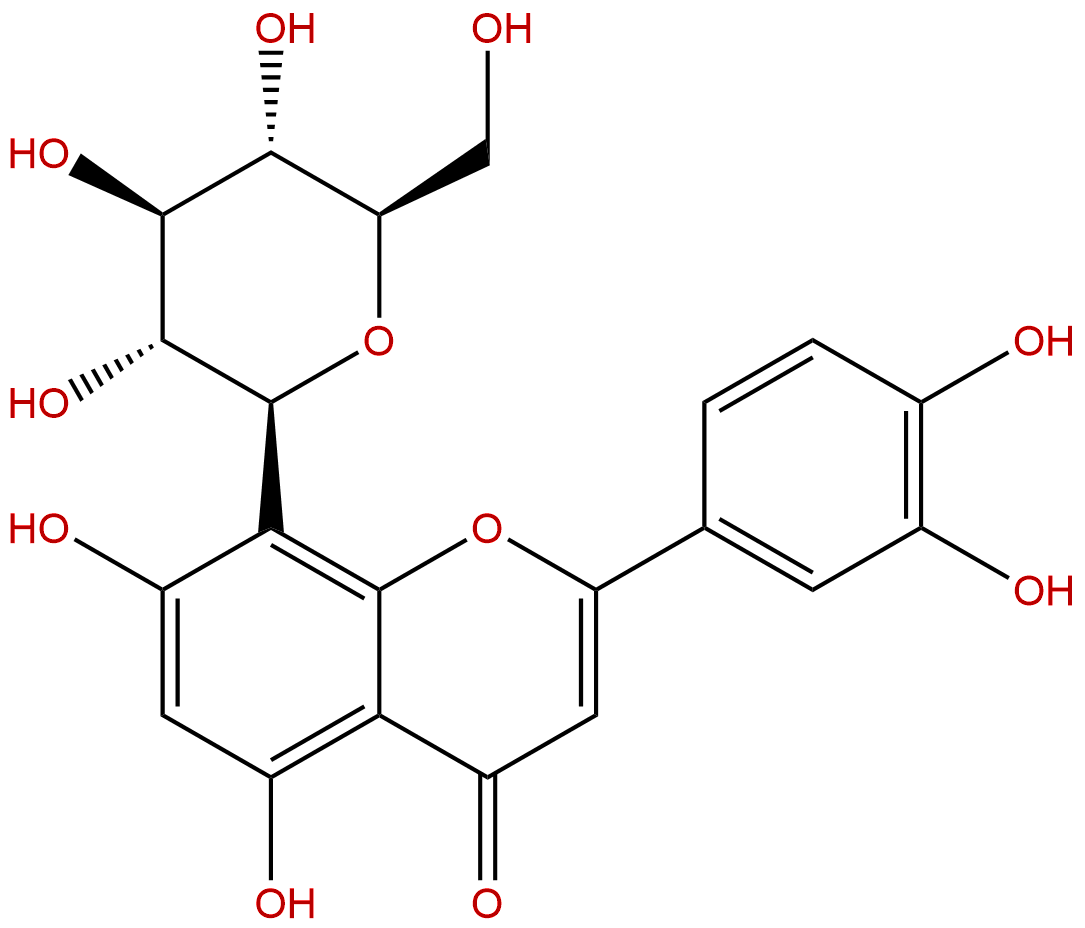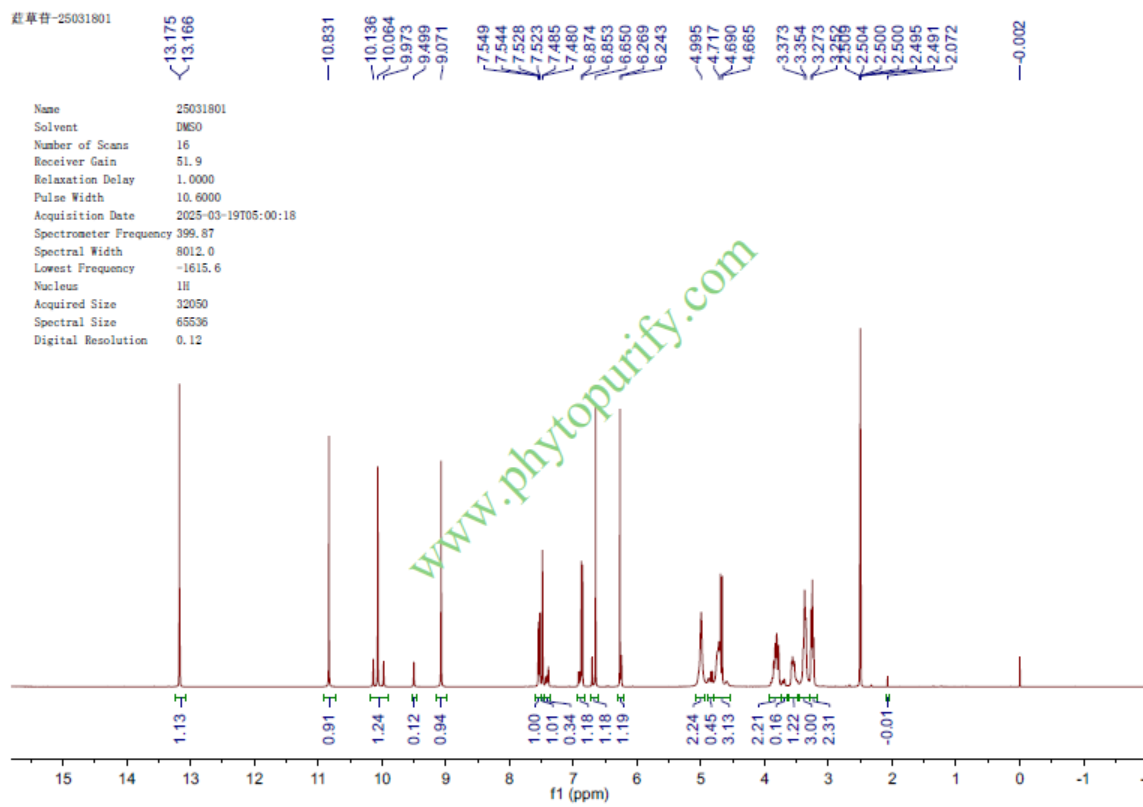
OrientinCAS No.:28608-75-5
|
||||||||||
 |
|
|
||||||||

| Catalogue No.: | BP1042 |
| Formula: | C21H20O11 |
| Mol Weight: | 448.38 |
Product name: Orientin
Synonym name: 8-Glucosylluteolin; Lutexin
Catalogue No.: BP1042
Cas No.: 28608-75-5
Formula: C21H20O11
Mol Weight: 448.38
Botanical Source: Trollius chinensis
Physical Description:
Type of Compound: Flavonoids
Purity: 95%~99%
Analysis Method: HPLC-DAD or/and HPLC-ELSD
Identification Method: Mass, NMR
Packing: Brown vial or HDPE plastic bottle
Storage: Store in a well closed container, protected from air and light. Put into refrigerate or freeze for long term storage.
The product could be supplied from milligrams to grams
Inquire for bulk scale.
Description:
Orientin has various activities including anti-oxidant, anti-aging, anti-viral, anti-bacterial, anti-inflammation, vasodilatation and cardioprotective, antiadipogenesis, antinociceptive, radiation protective, neuroprotective, and antidepressant-like effects. Orientin protects H9c2 cardio-mytocytes against I/R-induced apoptosis by modulating the mPTP opening, and this role of orientin may involve the PI3K/Akt signaling pathway; it also can decrease C/EBPα and PPARγ protein expression level in 3T3-L1 cells.
References:
Mol Med Rep. 2014 Mar;9(3):947-54.
Neuroprotective effects of orientin on hydrogen peroxide‑induced apoptosis in SH‑SY5Y cells.
This study investigated the neuroprotective effects of Orientin, which has been reported to be capable of crossing the blood‑brain barrier.
METHODS AND RESULTS:
The maximum non‑toxic dose (MNTD) of Orientin against SH‑SY5Y neuroblastoma cells was determined using a 3‑(4,5‑dimethylthiazol‑2‑yl)‑2,5‑diphenyltetrazolium bromide (MTT) assay. The effects of the MNTD and the half MNTD (½MNTD) of Orientin on cell cycle progression and intracellular reactive oxygen species (ROS) levels, as well as the activity of caspases 3/7, 8 and 9 after exposure to 150 µM of hydrogen peroxide (H2O2) were also determined using flow cytometry, a 2',7'‑dichlorodihydrofluorescein‑diacetate (DCFH‑DA) assay and caspase assay kits, respectively. The results revealed that Orientin at ≤20 µM was not cytotoxic to SH‑SY5Y cells. After treatment with Orientin at the MNTD, the percentage of apoptotic cells was significantly reduced compared with that in cells treated with 150 µM H2O2 alone. The results also showed that, although Orientin at the MNTD and ½MNTD did not reduce intracellular ROS levels, it significantly inhibited the activity of caspases 3/7. Caspase 9 was significantly inactivated with Orientin at the MNTD.
CONCLUSIONS:
Findings from this study suggest that the neuroprotection conferred by Orientin was the result of the intracellular mediation of caspase activity.
Radiat Res. 2000 Oct;154(4):455-60.
Radiation protection by the ocimum flavonoids orientin and vicenin: mechanisms of action.
In previous studies, flavonoids, Orientin and vicenin, that were isolated from the leaf extract of Ocimum sanctum, were found to protect mice against radiation injury. Several flavonoids are known to be good antioxidants. Therefore, the effect of Orientin and vicenin on radiation-induced lipid peroxidation in vivo and their antioxidant activity in vitro were studied.
METHODS AND RESULTS:
Adult mice were injected intraperitoneally with 50 microgram/kg of Orientin or vicenin and exposed whole-body to 3 Gy of gamma radiation. Lipid peroxidation was measured in the liver 15 min to 8 h postirradiation. The antioxidant activity of Orientin/vicenin (10-500 microM) was studied by measuring inhibition of hydroxyl radicals generated by the Fenton reaction (Fe(3+)-EDTA-ascorbic acid-H(2)O(2)) in vitro. The compounds were also tested for possible pro-oxidant and iron chelation activities at the above concentrations in the in vitro system. Orientin and vicenin provided almost equal protection against radiation-induced lipid peroxidation in mouse liver. Both compounds showed a significantly greater free radical-inhibiting activity in vitro than DMSO. Neither Orientin nor vicenin showed any pro-oxidant activity at the concentrations tested.
CONCLUSIONS:
Both compounds inhibited free radical formation in the absence of EDTA. Free radical scavenging appears to be a likely mechanism of radiation protection by these flavonoids.
Phytother Res. 2010 Oct;24(10):1543-8.
Vitexin, orientin and other flavonoids from Spirodela polyrhiza inhibit adipogenesis in 3T3-L1 cells.
To investigate the adipogenesis inhibitory effect on lipid accumulation, 3T3-L1 cells were treated with fractions and isolated flavonoids of Spirodela polyrhiza.
METHODS AND RESULTS:
An ethanol extract of S. polyrhiza was fractionated into three fractions. The butanol soluble fraction (SPB) exhibited potent antiadipogenesis activity and decreased C/EBPα and PPARγ protein expression level in 3T3-L1 cells without significant cytotoxicity. The flavonoids were isolated from SPB and their chemical structures were identified as chrysoeriol (1), apigenin (2), luteolin (3), vitexin (4), cosmosin (5), Orientin (6) and luteolin-7-O-β-d-glucoside (7) by spectroscopic analysis. Studies on the adipogenesis and intracellular triglyceride accumulation inhibitory effect showed that compounds 4 and 6 had the highest activity and decreased C/EBPα and PPARγ protein expression level in 3T3-L1 cells.
CONCLUSIONS:
These results suggest that the flavonoids isolated from SPB, especially compounds 4 and 6, contribute to the inhibitory activity of S. polyrhiza in 3T3-L1 cells.
Mol Nutr Food Res. 2015 Jun;59(6):1130-42.Orientin improves depression-like behavior and BDNF in chronic stressed mice.
Orientin, a phenolic compound abundant in some fruits, millet, and herbs, has been shown to have antioxidant properties. This study investigated the potential antidepressant effects of Orientinagainst chronic stress and its underlying mechanisms.
METHODS AND RESULTS:
The chronic unpredictable mild stress (CUMS) model was used to investigate the effects of Orientin on behavior and biochemical alterations in mice. After 2 weeks of the CUMS protocol, the mice were treated with Orientin (20 mg/kg and 40 mg/kg, oral gavage) for 3 weeks. Administration of Orientin significantly alleviated the CUMS-induced depression-like behavior, including sucrose preference reduction, locomotor activity decline, and hypomotility. Orientin treatment attenuated the oxidative stress markers and increased the concentrations of serotonin and norepinephrine in the hippocampus and prefrontal cortex of CUMS mice. Orientin treatment also increased the brain-derived neurotrophic factor and synapse-associated proteins (synaptophysin and postsynaptic density protein 95) of CUMS mice.
CONCLUSIONS:
Orientin exerts antidepressant-like effects on CUMS mice, specifically by improving central oxidative stress, neurotransmission, and neuroplasticity. Therefore, supplementation with Orientin-enriched food or fruit could be beneficial as a preventive strategy for chronic stress-induced depression.
HPLC of Orientin

HNMR of Orientin
